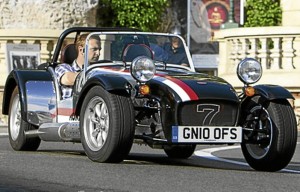Every year, many of us dream of getting a sports car for Christmas. But since we cannot afford to buy one, it remains a dream. Soon, though, that impossible dream may become a reachable reality if an aviation magnate in Malaysia succeeds in making “small, fun sports cars” affordable for Asian consumers.
To Formula One fans, Tony Fernandes is best known as the Malaysian mogul who brought back the Lotus brand to the world’s biggest, most spectacular and most expensive motor sport enterprise. Aside from owning AirAsia, the 10-year-old budget airline that stunned the aviation industry by placing the largest aircraft order in history with a request for 300 Airbus A320s over the course of the next five years, Fernandes recently acquired a 20-percent stake in Malaysia’s national carrier, MAS, and purchased the Queens Park Rangers soccer club in London. (Incidentally, AirAsia Philippines will begin flying from Clark in February 2012.)
A feature article in InMotion, the international magazine of the FIA [Federation Internationale de l’Automobile], quotes Fernandes as to why he bought the British niche sports car company Caterham Cars after Group Lotus, a subsidiary of Malaysia’s government-controlled Proton car company, took back the Lotus brand: “Apart from my passion for Formula One, and the fact that I loved doing something with the Lotus name, the reason I got into the sport was that I wanted to get into the car business. People who follow F1 sometimes forget that I am already in the transportation business with my airline. What they don’t realize is that I am interested in the automobile business as well.
Thrill of speed
“It is no great secret that Asians like the thrill of speed, but up to now, they have never been able to afford much. Their passion has evolved as they have been able to afford motor scooters, then motorbikes and, more recently, smaller cars as the ones that have been produced by Proton and its (Malaysian) national rival Perodua. But now the new Asian consumers can afford a little bit more and I believe that with their disposable income going up, small, fun sports cars will become affordable. And that is why I am in involved in the sport.
“… I have always said that Formula One should be as closely related as possible to the car business and that was one of the reasons that I got involved in Caterham Cars. It is not going to be a mass-market business but we hope that we will work with partners who are involved in the mass markets so that some of the technology that we have in F1 can flow down to the mass market consumers.”
Fernandes pointed out that right now, F1 technology benefits only super-luxury sports cars such as Ferraris, McLarens and high-end Porsches. But he thinks he can do the same in the affordable sports car bracket, which is the space that Lotus founder Colin Chapman originally created with the Lotus Seven. The Caterham Super Seven, which is based on the Lotus Seven, continues to sell well despite having been in production for 50 years.
Caterham F1
Last month, after amicably settling Team Lotus’ legal wrangles with Group Lotus, Fernandes got the FIA’s approval to change his team’s name to Caterham F1 in 2012. He told InMotion that Caterham is a good, undervalued brand with great heritage and goodwill that has lots of potential for growth beyond its European heartland. He said Caterham reminded him of AirAsia, which he took from a two-plane operation and built into a 100-plane one.
“We will try to make lightweight sports cars that are still affordable but will incorporate as much F1 technology as we possibly can,” Fernandes informed InMotion. “And we will take our experience in biofuels from the aviation industry and put that in there as well. So, in effect, we are trying to see whether we can take technology out of other interests and monetize it by making it available to a much bigger audience. There are millions and millions of people in Asia who watch the racing on television, but they cannot experience the thrill of the technology. We want to give them that opportunity.”
General Electric, which signed up as a sponsor of Fernandes’ F1 team aside from inking a $600 million aero-engine deal, will play a big role in his affordable sports car project. Noting that Formula One has not sold enough of its expertise to the car industry, Fernandes said that he and GE will exploit in every way they can forming a bridge between aviation and the automobile. He cited the collaborative potential with GE’s tremendous technology in all things electrical, in batteries, hybrids, charging systems and the billions of dollars GE has invested in research projects to save fuel—“technology that we can put into our cars and into aviation.”
Solutions
According to InMotion, Fernandes does not claim to be an engineer (he graduated from the London School of Economics in 1987)—he just asks questions and looks for solutions. For instance, he once asked his Formula One team whether a Kinetic Energy Recovery System (KERS) that is used by F1 cars can be put into a small sports car. “Everyone looked at me oddly but they must be able to mass-produce these things,” Fernandes recalls. “OK, maybe they will not recover as much as they can in Formula One but they must be able to do something. We are really going into the unknown. But that is part of the fun!”


